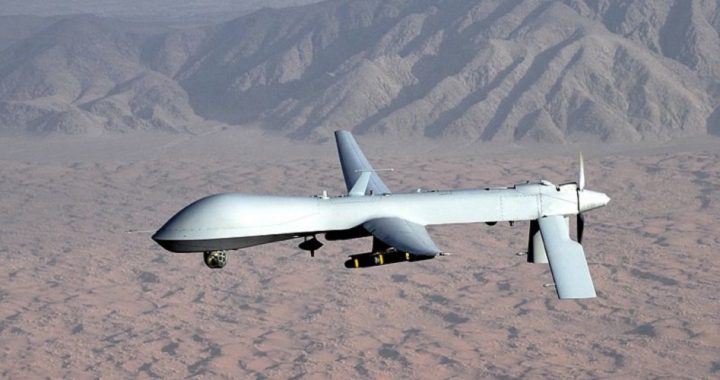
The “next phase of drone warfare” will extend “far beyond traditional, declared combat zones,” the Washington Post reports.
Africa, according to the report filed July 20, will see an enormous increase in the sorties of unmanned aerial vehicles remotely piloted by U.S. airmen. The commander of U.S. forces in Africa has purportedly requested a “15-fold increase in surveillance, reconnaissance and intelligence-gathering on the continent.”
Drone bases are going up all over Africa, so the multiplicity of missions will be easily accommodated. As the Post points out:
In Africa, the U.S. Air Force began flying unarmed drones over the Sahara five months ago to track al-Qaeda fighters and rebels in northern Mali. The Pentagon has also set up drone bases in Ethiopia, Djibouti and Seychelles.
Since being elected in 2008, Barack Obama has rapidly ramped up the drone war. Despite repeated promises to protect the rule of law and guarantee due process, the Nobel Peace Prize winner has overseen the death of thousands by drone strike. Not a single victim has ever been accused of any crime or allowed to answer those charges before an impartial judge — rights guaranteed to all persons by the Fifth Amendment to the Constitution.
To date, there have been more than 80,000 such missions flown in the Middle East and elsewhere.
This global expansion of the drone war seems to contradict President Obama’s statement made at the United Nations in 2011 that the “tide of war is receding.”
Not only will Africa “benefit” from the president’s apparent amnesia, but the Post story reports that Asia, the Pacific, and Colombia will all soon be receiving Reapers to aid in the “War on Terror,” and, in the case of Colombia, the equally feckless, futile, and unconstitutional War on Drugs.
This commitment to covert killing is more than a waste of resources, however. The death toll climbs, but even President Obama — the Kaiser of the Kill List — has no idea how many assassinations he has approved.
The uncertainty as to the number of innocent people murdered by U.S. drone attacks and discounted as acceptable collateral damage only cements the certainty of the fact that under President Obama, the United States maintains two kill lists from which targets are selected for summary execution at the hands of agents of our government. And they don’t bother counting the corpses.
Beyond the headlines, one of the most disturbing and damning accounts of the effect of the Obama administration’s drone war on the civilian population of Pakistan — the most frequent target of the attacks — was highlighted recently by The New American.
The report entitled “Living Under Drones: Death, Injury and Trauma to Civilians From US Drone Practices in Pakistan” was co-authored by the law schools of Stanford and New York Universities and contains on-the-ground accounts of the myriad ways that President Obama’s drone-delivered program of assassination is devastating the lives of ordinary Pakistanis who have no connection to terror other than the fact that they are being constantly terrorized by the government of the United States.
Glen Greenwald of the Guardian (U.K.) artfully describes the situation on the ground in Pakistan:
The people in the areas targeted by Obama’s drone campaign are being systematically terrorized. There’s just no other word for it. It is a campaign of terror — highly effective terror — regardless of what noble progressive sentiments one wishes to believe reside in the heart of the leader ordering it. And that’s precisely why the report, to its great credit, uses that term to describe the Obama policy: the drone campaign “terrorizes men, women, and children.”
Twenty-seven pages of the 182-page document are devoted to enumerating the various ways the use of drones in the White House and CIA’s targeted killing programs are rattling the already war-ravaged psyches of the civilian population of Pakistan.
For example, in the subsection entitled “Mental Health Impacts of Drone Strikes and the Presence of Drones,” the authors relate the story of two-time Pulitzer Prize winning reporter David Rohde who was kidnapped in November 2008 and held for seven months by the Taliban while covering Afghanistan and Pakistan for the New York Times in the Federally Administered Tribal Areas (FATA) of northwest Pakistan. Rohde’s story as quoted in the drone report: “The drones were terrifying. From the ground, it is impossible to determine who or what they are tracking as they circle overhead. The buzz of a distant propeller is a constant reminder of imminent death.” Describing the experience of living under drones as “hell on earth,” Rohde explained that even in the areas where strikes were less frequent, the people living there still feared for their lives.
Many in the United States may discount the importance of such a story, pointing out that such an existence is the price of harboring terrorists and those intent on threatening the national security of the United States.
One wonders if that attitude will change in the next couple of years when 30,000 drones fill the skies of the United States. Will we come to know the ever-present sound of a “distant propeller” stirring up the otherwise placid domestic skies with the inimitable buzz of imminent death? Will we live in constant fear of “when is the next drone attack going to happen” as one mental health professional hears daily from the men and women of Waziristan?
One of the most horrifying tactics reportedly used by the United States in the prosecution of the death-by-drone program is the so-called “double tap.” The Stanford/NYU report brought this to light and an article in the Daily Mail (U.K.) accurately summarized the practice: “A drone fires one missile — and then a second as rescuers try to drag victims from the rubble. One aid agency said they had a six-hour delay before going to the scene.” According to the story this insupportable and inhumane tactic is resulting in the death of “49 people for every one known terrorist in Pakistan.”
Often, the story is reported, surviving relatives of those killed by the drone assaults are denied the opportunity to bury their dead and perform the ancient rites associated with placing a body in its final resting place. One man severely injured in a drone attack reports that “people are reluctant to go to the funerals of people who have been killed in drone strikes because they are afraid of being targeted.”
Page 92 of the document recounts interviews of several Pakistanis who were intentionally targeted by the Hellfire missiles fired at funerals. The grief experienced and related by these men is evident, heart-wrenching, and demoralizing.
One man who lost several relatives in a drone strike tells how the dead from that strike were buried: “They held a funeral for everybody, in the same location, one by one. Their bodies were scattered into tiny pieces. They … couldn’t be identified,” said Massod Afwan.
Is this the sort of behavior that qualifies the area and the attendants to be lit up by a “signature strike” — a strike based not on suspicion of guilt, but of a “pattern of behavior”?
To put it another way, if your uncle, a notorious and despicable mobster, was laid to rest and you attend his funeral, would it be lawful for the FBI to shoot you (and any other members of your family at the gravesite) on the spot for displaying behavior indicative of affiliation with the Mafia or associated forces?
As the president and his spokesmen have made clear for years, the world is now a battlefield and the Washington Post story indicates that drones — the White House’s weapon of choice — will soften the beach for the opening of new theaters of military operations around the world.
Joe A. Wolverton, II, J.D. is a correspondent for The New American and travels frequently nationwide speaking on topics of nullification, the NDAA, and the surveillance state. He can be reached at [email protected]



